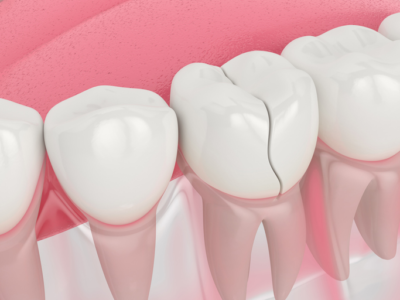Have you ever experienced distress while eating? Has a cup of hot coffee or cold ice cream made you jump off the sofa? If you answered yes to either of these, you may have symptoms of a cracked tooth that can progress if not treated in a timely manner. In some instances, the parts of the tooth move precariously during eating and irritate the live nerve. This slight movement increases the risk of pain and spread of infection to the adjacent gums and bone.
 WHAT IS A CRACKED TOOTH?
WHAT IS A CRACKED TOOTH?
Many people view beautiful, healthy teeth as a positive asset to their physical appearance and overall well-being. Therefore, a cracked tooth often causes physical discomfort but also a decrease in self-confidence. A cracked tooth is a fracture in a tooth’s surface, ranging from a superficial fracture in the outer layer of tooth structure all the way to a deep fracture extending into the nerve. A superficial crack always has the potential to grow if left untreated. A deep crack is often accompanied by pain upon biting and sensitivity to hot and cold stimulation. Some of the most common surfaces of teeth in which cracks originate are the biting surfaces.
On many occasions, the tooth remains intact with visible fracture lines evident only upon close evaluation. With time and continued use, the crack may gradually spread. Teeth with cracks are more susceptible to decay because they have an access site for bacteria and plaque to enter. The good news, however, is that these cracks can often be restored with a resin filling material or full coverage crown to prevent further damage.
HOW DOES A CRACK HAPPEN IN A TOOTH?
Cracked teeth can be caused by a multitude of things, including stress, biting on a hard food/object, long term wear or a freak accident. Using your teeth as a tool often results in fracture. Your teeth were not designed to bite off a price tag, open a canned drink or cut your fingernails. Sometimes biting into foods such as nuts, hard candies or crunchy chips can also result in cracked teeth. Everyone has heard that crunching ice increases the risk of tooth fracture, and that statement has earned its reputation due to the frequency with which it happens. The repetitive, undue stress of any of these behaviors ultimately causes the fracture to occur. Habits, such as grinding and clenching, leads to wear and can also contribute to the development of tooth cracks.
It is important to catch signs of a cracked tooth early to prevent significant damage, such as nerve involvement or fracture into the root, This makes the tooth “non-restorable”. A tooth is composed of an outer layer of enamel, which is the hardest, most protective layer; an inner layer of dentin, which is a bit softer and more sensitive when exposed; and pulp, which contains the nerves and blood vessels. If you feel a piercing pain upon biting or have sensitivity while eating hot or cold food. You should see your dentist for evaluation of a potential cracked tooth.
HOW TO TREAT A CRACKED TOOTH?
The best treatment for a cracked tooth depends on the location of the fracture and how deep the fracture extends into the layers of the tooth. Regular recall appointments to your dentist are important because some fracture lines can be monitored at each of those visits as long as they are not spreading. Once a crack shows evidence of growth, or becomes symptomatic, treatment is often recommended.
Treatment options for a cracked tooth are:
1. Restoration with a resin bonding material to include all aspects of the fracture
2. Placement of a full coverage crown if the fracture includes multiple tooth surfaces
3. Root canal & full coverage crown if the fracture extends to the nerve
4. Extraction of the tooth if the crack extends down the root of the tooth beyond the bone level
In cases where the crack involves the nerve, a root canal may be required to relieve the pain. A root canal involves removing the nerve and blood vessels of the tooth so there’s no feeling or sensation. A material is used to fill the space of the tooth where the nerve used to be and a crown is placed over the tooth for prevention of further fracture. If the crack has split the roots of the tooth, the tooth is deemed “non-restorable,”. This would require that the tooth be removed. However, do not fret because there are always options to replace missing teeth if this were to occur.
WHAT SHOULD I DO?
Although most cracks are caught early and are treatable. It is best to see your dentist as soon as you notice any changes in the feel or look of the tooth. Your dentist will be able to evaluate the tooth clinically and with x-rays to determine the best course of action for long term success! Prevention is key, so acknowledging and addressing any habits that may make you prone to tooth fracture can help avoid future problems!



